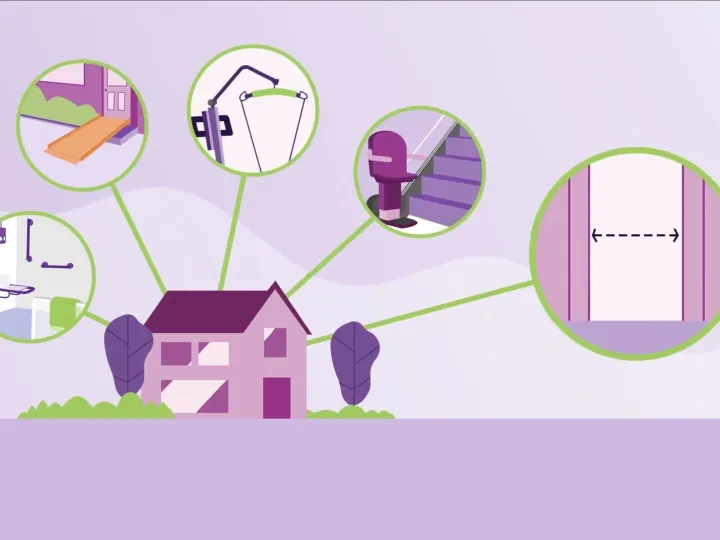The Shift Towards Universal Design
Inclusive design should be great design! Paul Smith, Director of Foundations, explains how Universal Design is reshaping bathroom adaptations.
Back in 2018, during the DFG Champions Roadshows, I stood in front of a room full of housing and social care professionals and made a simple argument: Why does so much disability equipment look like it belongs in a hospital?
Grab rails, toilet frames, shower seats – most of it is purely functional, designed with one goal in mind: keeping people safe. But while safety is obviously important, the way these products look and feel also matters. If a bathroom adaptation makes someone feel like they're in a clinic rather than their own home, it affects how they live, how they feel, and whether they even use the equipment in the first place.
I remember one particular moment from those early roadshows. Someone told me they could buy a white plastic grab rail for 99p. I replied that it might only cost 99p, but it costs over £30 to fit, and in many cases, it gets ripped out the moment it's no longer needed. That's not a great investment. But if we fit something that actually looks good – something that blends into the home – it's more likely to stay there. And if it stays, it can prevent the next person from falling before they even reach the stage of needing major adaptations.
The Shift Towards Universal Design
Fast forward to today, and it's clear that things are starting to change. At this year's DFG Champions Roadshows, we've been hearing from two of the biggest manufacturers and distributors of bathroom adaptation equipment. And what they're saying confirms what many of us have believed for years:
Attractive, well-designed adaptations don't have to cost more.
In some cases, they can even be cheaper.
The assumption that 'clinical-looking' adaptations are the only affordable option simply isn't true anymore. Universal Design – creating products that work for everyone, regardless of age or ability – is becoming mainstream.
Why Good Design Matters
Let's put this into perspective. Imagine two bathrooms:
Bathroom A: A standard DFG adaptation with exposed grab rails, a bulky toilet frame, and a plastic shower seat. The user might find it useful, but they may also feel self-conscious about their bathroom looking 'medical.' They might avoid inviting guests over or even hesitate to use the equipment themselves.
Bathroom B: A thoughtfully designed space with discreet, integrated grab rails, stylish but functional fixtures, and a shower seat that looks like part of the furniture. It serves the same purpose, but the person using it feels at home – not in a clinic.
The difference is dignity. A well-designed adaptation doesn't just improve function – it enhances wellbeing, confidence, and quality of life.
The Economics of Better Design
It's not just about aesthetics. When adaptations are designed to be long-term features rather than short-term fixes, we reduce waste and increase value for money.
A traditional grab rail is often installed as a temporary measure. Once it's no longer needed, it's removed, leaving holes in the wall. That means additional repair costs.
But a well-integrated support rail can stay in place. It serves the current user, remains useful for future occupants, and helps prevent falls – potentially avoiding the need for further adaptations down the line.
If we get this right, we're future-proofing homes rather than constantly reacting to crisis situations.
How the Market is Changing
One of the biggest barriers to better design has always been supply and demand. Manufacturers weren't producing stylish, affordable adaptations because local authorities weren't asking for them. And local authorities weren't asking for them because they assumed they didn't exist, or that they were too expensive.
That's why I've spent years arguing that if we start fitting better products, the market will respond.
And it's happening.
Manufacturers are investing in better design. There are now grab rails that look like towel rails, toilet supports that blend into furniture, and shower seats that wouldn't look out of place in a high-end hotel. These products are no longer just for 'disabled people' – they're for everyone.
This shift means that when housing teams, OTs, and grant officers look at options for adaptations, they're no longer choosing between clinical and expensive or cheap but ugly. There's a third option: products that are safe, look good, and fit within the same price range.
The Next Step: Making Good Design the Standard
While progress has been made, there's still work to do.
Many local authorities and home improvement agencies still default to traditional, clinical-looking adaptations because that's what's familiar. Specifications need to change. Procurement processes need to evolve. The people making decisions about DFG-funded adaptations need to see the alternatives for themselves.
Foundations is already working on this, collaborating with manufacturers and suppliers to promote better design choices and helping local authorities integrate these options into their adaptation programs. We are also developing a good practice specification and exploring options under the new procurement regulations to ensure that better-designed adaptations become the norm rather than the exception.
This isn't just about improving people's homes – it's about changing mindsets.
If we embed Universal Design principles into everything we do, we'll reach a point where nobody has to ask whether something is functional or attractive -because the answer will always be both.
That's the future we should be aiming for. And the good news is, it's already beginning to happen.




